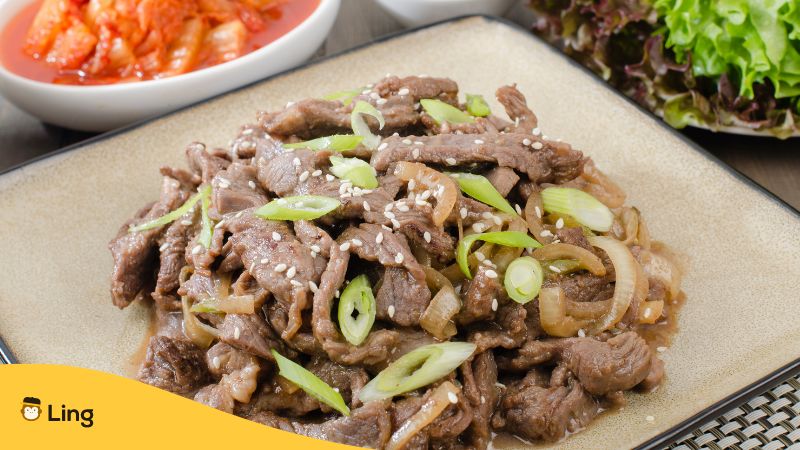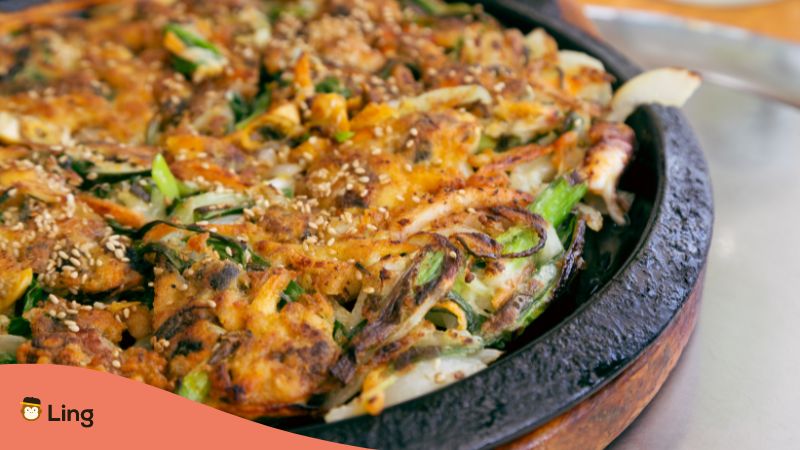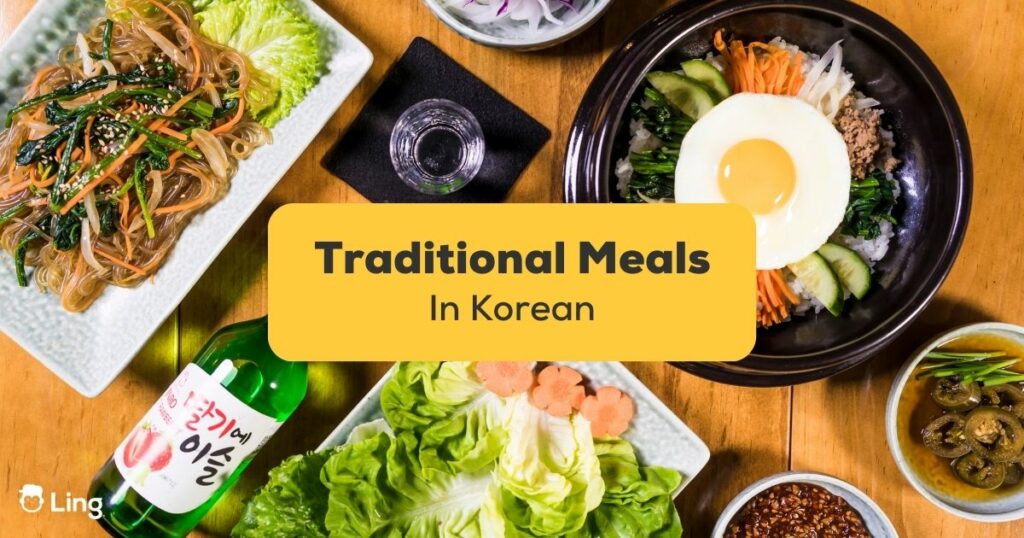Ready to dive into the mouthwatering world of traditional Korean meals? Trust me, it’s not just about Korean fried chicken and dumplings (though they’re amazing, too). Traditional Korean food is a vibrant tapestry of flavors, textures, and colors that reflects the country’s rich cultural heritage. And guess what? Learning about these scrumptious dishes is a fantastic way to boost your Korean language skills!
Why, you ask? Well, knowing your way around food-related vocab helps you connect with native speakers, navigate menus like a pro, and truly immerse yourself in Korean culture. So, grab your chopsticks, and let’s explore these ten must-try traditional Korean meals that’ll make your taste buds (and your language learning) soar!
Traditional Korean Meals You Should Try
Ready to take a bite out of Korea’s rich culinary scene? Here’s our drool-worthy list of must-try traditional Korean meals that’ll have you saying 잘 먹겠습니다 (I’ll eat well) in no time!
Kimchi (김치)
Kimchi is the spicy, tangy, and oh-so-delicious MVP of a traditional Korean meal. It’s not just a side dish—it’s a way of life! Kimchi is all about fermented vegetables, usually napa cabbage, seasoned with a mix of spices, garlic, ginger, and soybean paste. Plus, it comes in hundreds of different varieties. It’s like the ultimate choose-your-own-adventure meal.
The secret to kimchi’s addictive flavor? A mix of red pepper flakes, garlic, ginger, and fish sauce creates that signature zing. But wait, it gets better! Kimchi is scrumptious and packed with healthy probiotics, vitamins, and minerals. Talk about a win-win situation.
So, while you’re busy learning Korean, make sure to indulge in some “kimchi” (김치). It’s the perfect tongue-tingling treat to fuel your language journey!
Bibimbap (비빔밥)
Feast your eyes (and your taste buds) on Bibimbap, or 비빔밥 in Hangul. This vibrant Korean dish is a mouthwatering masterpiece and a language learner’s dream come true. Why? Because “bibim” (비빔) means “mixed,” and “bap” (밥) means “rice.” Now you’re speaking Korean!
Bibimbap starts with a fluffy bed of cooked rice, topped with an eye-catching arrangement of sautéed veggies, thinly sliced meat, and a beautifully fried egg. The finishing touch? A generous dollop of gochujang, Korea’s famous spicy red pepper paste. It’s like a flavor explosion waiting to happen.
But the real fun begins when you grab your spoon and mix it all up. The result is a perfectly balanced symphony of tastes and textures in every bite. So, dive into a bowl of 비빔밥 and let the colors and flavors of Korea inspire you as you learn the language!
Bulgogi (불고기)
Get ready to drool, language learners, because we’re about to introduce you to Bulgogi (불고기). This Korean classic will have you licking your lips and craving more while expanding your vocabulary. You see, 불 (bul) means “fire,” and 고기 (gogi) means “meat”—so you’re literally enjoying some fire meat!
Bulgogi features tender, thinly sliced beef marinated in a mouthwatering soy sauce, sugar, garlic, and sesame oil blend. The result? A succulent symphony of sweet, salty, and garlicky goodness that’ll leave you speechless—except for the occasional “mmm” between bites.
Whether you savor it straight off the grill or piled high in a lettuce wrap, Bulgogi is a must-try dish for any language learner exploring Korean cuisine.

Naengmyeon (냉면)
Looking for something refreshing and tasty to beat the summer heat? Look no further than Naengmyeon! This traditional Korean dish literally means “cold noodles.” It’s the perfect way to cool off during those hot and humid days.
Naengmyeon (냉면) is made with thin, chewy cold buckwheat noodles, served in a chilled, tangy broth. The icy-cold soup is usually made from beef, chicken, or a mix of both.
But wait, there’s more! Along with the noodles, you’ll find toppings like julienned cucumber, boiled egg, and thin slices of Korean pear. Some people even add a bit of spicy mustard or vinegar to give it an extra kick. Yum!
Samgyeopsal (삼겹살)
Get ready to fire up the grill and make some new friends over a mouthwatering meal of Samgyeopsal! This Korean BBQ favorite is not only scrumptious, but it’s also a super fun dining experience.
Samgyeopsal, which translates to “three-layered meat,” is all about juicy, marinated pork belly slices grilled right at your table. The best part? You get to cook it yourself! Once the meat is nicely browned and crispy, you can wrap it in fresh lettuce leaves with rice, kimchi, and other tasty side dishes.
In addition, your mouth will experience one of the best flavor explosions when trying Samgyeopsal with its special dipping sauce made of garlic, Doenjang, and Gochujang called “Ssamjang” (쌈장). Ssamjang, meaning “paste for wraps,” is a favorite of Koreans as it tastes delicious with vegetables.
Samgyetang (삼계탕)
Feeling a bit under the weather or in need of a comforting meal? Samgyetang (삼계탕) is here to save the day! This nourishing, traditional Korean soup is like a warm hug in a bowl.
Samgyetang, which means “Korean ginseng chicken soup,” is all about a tender, whole young chicken stuffed with sweet rice, ginseng, jujubes, and other nutritious ingredients. The soup is slowly simmered to create a rich and flavorful broth that’ll make your taste buds sing and revitalize your body.
This delicious dish is perfect for chilly days and is also enjoyed as a summer treat during the hottest days of the year. Why? It’s believed to help fight off the heat by replenishing your energy and nutrients. Talk about a win-win!

Jjajangmyeon (짜장면)
You simply can’t talk about traditional Korean meals without mentioning Jjajangmyeon! This mouthwatering dish is all about thick, chewy noodles coated in a rich, savory black bean sauce. A perfect blend of flavors!
Jjajangmyeon has roots in Chinese cuisine, but the Korean people have fully embraced and adapted it. You’ll find this dish in every Korean-Chinese joint, and it’s a go-to comfort food for many locals. It’s not just the taste that’ll win you over, though. Jjajangmyeon (짜장면) has a fascinating history, too!
Tteokbokki (떡볶이)
Get ready to turn up the heat with Tteokbokki, a scrumptious Korean street food classic guaranteed to spice up your language-learning journey.
This popular dish is all about chewy sliced rice cakes swimming in a sweet and spicy sauce. These Korean rice cakes are made with glutinous rice flour, giving a signature sticky texture. Trust me, your taste buds will thank you!
Tteokbokki (떡볶이) is a beloved snack you’ll find almost everywhere in Korea, from bustling street markets to cozy neighborhood eateries. This Korean rice cake dish is not only a tasty treat but a social experience, too! If you’re in South Korea, be prepared to see groups of friends huddled around a steaming plate of this Korean meal or eating roasted sweet potatoes.
Sundubu-Jjigae (순두부찌개)
Ready for something warm, comforting, and packed with flavor? Meet Sundubu-jjigae, a traditional Korean stew that’s perfect for tofu lovers. It’s a must-try dish that’ll make you fall in love with Korea’s amazing culinary scene.
Sundubu-jjigae (순두부찌개) is all about soft tofu swimming in a spicy, savory broth. The secret to its deliciousness? A mix of garlic, onions, and gochugaru (Korean red pepper flakes) gives it a kick you won’t forget. And, of course, there’s the protein: you’ll often find it loaded with seafood or meat.
This cozy stew is served bubbling hot in a clay pot, which keeps it warm throughout your meal. Trust me. You’ll want to scoop up every last drop with a spoon or mix it up with some rice.
Haemul-Pajeon (해물파전)
Do you want to try cooking Korean food that’s mouthwatering and super fun to make? Look no further than Haemul-pajeon (해물- seafood 파전 – pancake), a delicious and savory seafood pancake that’ll have you coming back for seconds (or thirds!).
Haemul-pajeon combines fresh seafood like shrimp, squid, and clams with crispy green onions in a tasty pancake batter. The result? A delightful mix of flavors and textures that’ll make your taste buds dance with joy.
Whipping up Haemul-pajeon is a breeze. Just mix the ingredients, pour the batter into a hot frying pan, and flip it when it’s golden brown. Voilà! You’ve got yourself a scrumptious Korean treat.

Keep Exploring And Savoring
Well, folks, there you have it—ten unforgettable traditional Korean meals that are sure to tantalize your taste buds while deepening your understanding of Korean culture. As a language learner, exploring a country’s cuisine is an incredibly fun and effective way to make connections with the language you’re studying.
So, go ahead and step out of your comfort zone. Visit a local Korean restaurant or attend a Korean cooking class. As you continue to master the language, you’ll also be mastering the art of Korean cuisine, which is a pretty delicious skill to have.
Remember, language learning is a journey of new experiences, and food is a universal language that brings people together. So grab your chopsticks, get ready to dig in, and most of all, have fun exploring the flavorful world of Korean cuisine. Happy eating, and 화이팅 (fighting)!
Learn Korean With Ling App
Are you ready to dive into the world of languages? Look no further than the Ling app! Designed to make language learning fun, engaging, and accessible, Ling offers a variety of entertaining lessons, quizzes, and games to help you master your chosen language.
Whether you’re a beginner or a polyglot, the Ling app caters to all levels and learning styles. With our app, you’ll be speaking confidently in no time! And the best part? You can learn anytime, anywhere, right from your smartphone. So why wait?
Download the Ling on Play Store or App Store today!






















